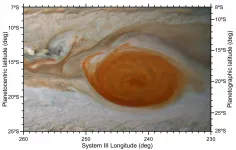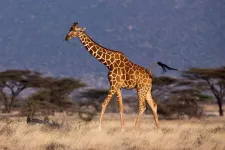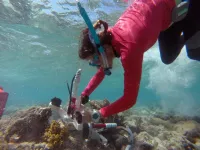Polystyrene waste is everywhere
Scientists just found a way to break it down
2021-03-17
(Press-News.org) Scientists at the U.S. Department of Energy's Ames Laboratory and their partners from Clemson University have discovered a green, low-energy process to break down polystyrene, a type of plastic that is widely used in foam packaging materials, disposable food containers, cutlery, and many other applications.
Polystyrene is part of a much larger global plastic waste problem. Hundreds of millions metric tons of polymers are produced each year, a large majority of which is discarded after use. Due to the chemical stability and durability of industrial polymers, plastic waste does not easily degrade in landfills and is often burned, which produces carbon dioxide and other hazardous gases. In order to stop the growing flood of polymer waste and reduce carbon dioxide emissions, plastics have to be recycled or converted into new value-added products.
Currently, recycling of the vast majority of plastics is not economically feasible; their sorting and separation are time and labor intensive, while chemical processing and remanufacturing requires a significant energy input and toxic solvents. Re-processed polymers often show inferior performance to that of the freshly manufactured "made from scratch" materials.
A team of scientists at Ames Laboratory used processing by ball-milling to deconstruct commercial polystyrene in a single step, at room temperature, in ambient atmosphere in the absence of harmful solvents. Ball-milling is a technique that places materials in a milling vial with metal ball bearings which is then agitated until a desired chemical reaction occurs. Called mechanochemistry, this experimental approach has numerous applications in new materials synthesis, and attractive features where plastics recycling is concerned.
The deconstruction of polystyrene proceeds through a series of chemical events involving mechanical cutting apart of the macromolecules, which generates free radicals detectable in the milled material even after its prolonged exposure to air. The metal bearings used for milling and the ambient oxygen act as co-catalysts that enable extraction of the monomeric styrene from the oligomeric radical-bearing species formed. The experiments showed that the temperature rise in the material during milling is not responsible for the observed phenomenon since the temperature inside the milled powder does not exceed 50oC while the thermal decomposition of polystyrene in air starts at about 325oC. The Clemson's group confirmed the comprehensive deconstruction of the original polymer into smaller fragments, oligomeric materials, suitable for further processing into new value-added products.
"This method represents an important breakthrough that enables dismantling of a polymer simultaneously with its break-down under ambient conditions, that is, ~300oC below the thermal decomposition temperature of the pristine material" said Ames Laboratory Senior Scientist Viktor Balema. "We think this proof of concept is an exciting possibility for developing new recycling technologies for all kinds of plastics, and that will contribute to establishment of the circular economy."
His partner from Clemson University, Kentwool Distinguished Professor Igor Luzinov, further commented that "this discovery opens new avenues for low temperature recovery of monomers from multicomponent polymer based systems such as composites and laminates. Also, our technology will allow extracting the monomer from crosslinked materials containing styrene units in their structures."
Alfred P. Sloan Foundation Research Fellow, Professor Aaron Rossini of Iowa State University, further noted that "electron paramagnetic resonance spectroscopy shows large concentrations of free radical carbon-centered species in polystyrene that was milled in air. This is a startling result because free radicals are normally very reactive. Also, the presence of the radicals gives direct evidence that the milling directly causes scission of the polymer chains. We expect that the reactive sites associated with the free radicals can be used to functionalize the processed polymers to obtain new value-added products."
INFORMATION:
The research was funded in part by Ames Laboratory's Laboratory Directed Research and Development (LDRD) Program.
The research is further discussed in the paper "Depolymerization of polystyrene under ambient conditions," authored by Viktor P. Balema, Ihor Z. Hlova, Scott L. Carnahan, Mastooreh Seyedi, Oleksandr Dolotko, Aaron J. Rossini, and Igor Luzinov; featured on the front cover of the New Journal of Chemistry.
Ames Laboratory is a U.S. Department of Energy Office of Science National Laboratory operated by Iowa State University. Ames Laboratory creates innovative materials, technologies and energy solutions. We use our expertise, unique capabilities and interdisciplinary collaborations to solve global problems.
Ames Laboratory is supported by the Office of Science of the U.S. Department of Energy. The Office of Science is the single largest supporter of basic research in the physical sciences in the United States, and is working to address some of the most pressing challenges of our time. For more information, please visit https://energy.gov/science.
ELSE PRESS RELEASES FROM THIS DATE:
2021-03-17
Combining tissue engineering and regenerative medicine, scientists have fabricated a series of heart valve replacements with the ability to incorporate host cells, enabling them to regenerate and grow over time. The valves expanded and maintained their function for a year when implanted into growing lambs, suggesting they could address the dire need for a long-term valve replacement for children with congenital heart disorders. These pediatric patients depend on mechanical or prosthetic heart valves for survival, but current devices often calcify over time and cannot grow alongside the ...
2021-03-17
WASHINGTON-- The stormy, centuries-old maelstrom of Jupiter's Great Red Spot was shaken but not destroyed by a series of anticyclones that crashed into it over the past few years.
The smaller storms cause chunks of red clouds to flake off, shrinking the larger storm in the process. But the new study found that these disruptions are "superficial." They are visible to us, but they are only skin deep on the Red Spot, not affecting its full depth.
The new study was published in the Journal of Geophysical Research: Planets, AGU's journal for research on the formation and evolution of the planets, moons and objects of our solar system and beyond.
"The intense vorticity of the [Great Red Spot], together with its larger size and depth compared to the interacting vortices, ...
2021-03-17
Toronto, ON -A new study published in the journal Substance Use and Misuse has found that adverse childhood experiences, such as physical and sexual abuse and neglect, predict greater performance-enhancing substance use in young adults.
Analyzing a sample of over 14,000 U.S. young adults from the National Longitudinal Study of Adolescent to Adult Health, researchers found that adverse childhood experiences are strongly associated with both legal (e.g., creatine monohydrate) and illegal (e.g., anabolic-androgenic steroids) performance-enhancing substance use. This relationship was especially strong among individuals who experienced ...
2021-03-17
(March 17, 2021) -- Eric Shattuck, assistant professor of research in the UTSA Institute for Health Disparities Research (IHDR) at The University of Texas at San Antonio, is studying the phenomenon of social distancing in response to infectious disease and its effects on pathogen transmission and the health of individuals and communities.
Many animals, including humans, exhibit behavioral changes during the early stages of an infection, including reduced social contacts, called sickness behavior. His findings suggest innate social distancing might help prevent the infection ...
2021-03-17
Gun violence in popular prime-time broadcast television dramas has increased steadily over almost two decades, a trend that parallels the rise in U.S. homicide deaths attributable to firearms, according to research by the Annenberg Public Policy Center (APPC) of the University of Pennsylvania.
Overall gun violence on popular prime-time dramas doubled from 2000 through 2018, according to the study, which was published in PLOS ONE. More important, gun violence as a proportion of the violence depicted in the shows rose significantly as well.
"Our research found that gun use substantially increased from 2000 to 2018 on prime-time ...
2021-03-17
A study led by researchers at the University of California San Diego Jacobs School of Engineering provides new insights for developing therapies for muscle disease, injury and atrophy. By studying how different pluripotent stem cell lines build muscle, researchers have for the first time discovered how epigenetic mechanisms can be triggered to accelerate muscle cell growth at different stages of stem cell differentiation.
The findings were published Mar. 17 in Science Advances.
"Stem cell-based approaches that have the potential to aid muscle regeneration and growth would improve the quality of life for many people, from children ...
2021-03-17
ROCHESTER, Minn. -- Pharmacogenomics is a valuable tool for health care providers to help prescribe the right drug for the right patient to enhance efficacy and avoid side effects.
A new research paper funded in part by the National Heart, Lung and Blood Institute (NHLBI) shows a clear advantage of genetic testing in helping health care providers choose the appropriate anti-platelet drug. Testing helps determine if a patient carries genetic variants in CYP2C19 that cause loss of its function. These variants interfere with the body's ability to metabolize and activate clopidogrel, an anti-platelet medication.
Anti-platelet drugs are given to prevent complications from blood clotting after a procedure to open clogged arteries. These patients can use one of ...
2021-03-17
While scientists have known that creatures may adjust the timing of their daily routines based on starvation and predation, these shifts have only previously been measured based on data from a population at a single point in time. Now, using data collected as 71 elephant seals undertook their foraging migrations across the North Pacific Ocean, researchers report a view of how these animals divide their time between light and darkness to optimize tradeoffs between risks and rewards based on 7 months of data per seal, collected between 2004 and 2012. Their findings refute a hypothesis about how seals prioritize feeding. To better understand how seals divide their time between light ...
2021-03-17
The giraffe is a truly puzzling animal. With its exceptional anatomy and suite of evolutionary adaptations, the giraffe is an outstanding case of animal evolution and physiology. Now, an international team of researchers from the University of Copenhagen and Northwestern Polytechnical University in China have produced a high-quality genome from the giraffe and investigated which genes are likely to be responsible for its unique biological features.
The extraordinary stature of the giraffe has led to a long list of physiological co-adaptations. The blood pressure of the giraffe, for instance, is twice as high as in humans and ...
2021-03-17
Washington, DC-- Algae colonizing dead coral are upending scientists' ability to accurately assess the health of a coral reef community, according to new work from a team of marine science experts led by Carnegie's Manoela Romanó de Orte and Ken Caldeira. Their findings are published in Limnology and Oceanography.
Corals are marine invertebrates that build tiny exoskeletons, which accumulate to form giant coral reefs. Widely appreciated for their beauty, these reefs are havens for biodiversity and crucial for the economies of many coastal communities. But they are endangered by ocean warming, seawater ...
LAST 30 PRESS RELEASES:
[Press-News.org] Polystyrene waste is everywhere
Scientists just found a way to break it down


